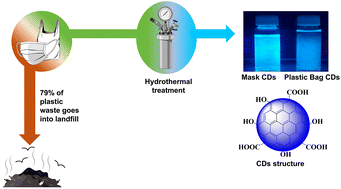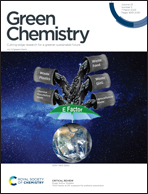High-yield, one-pot upcycling of polyethylene and polypropylene waste into blue-emissive carbon dots†
Abstract
The COVID-19 pandemic has led to unprecedented demand for single-use plastics such as plastic bags and surgical masks. Plastics are resistant to natural degradation and are a global environmental pollution problem, threatening the environment and human health. Finding suitable ways to convert plastic waste into valuable materials is crucial to mitigate these effects. Herein, we report a facile, single-step, and organic solvent-free hydrothermal process to convert polyethylene-based plastic bags and polypropylene-based surgical masks into carbon dots with a 96% production yield. The produced CDs are soluble in aqueous and various organic solvents, show excitation-dependent emission consistent with their size of 1–8 nm and exhibit thermal and photostability. We further show how this oxidative degradation approach can upcycle contaminated plastics with organic waste, which is a major challenge with plastic recycling. Finally, we demonstrate a potential use case of CDs as anticounterfeiting agents using fluorescent, stretchable films of CD-doped polydimethylsiloxane (PDMS). This synthesis method is a cost-effective, easy-to-implement, highly scalable, and contamination-resistant approach to upcycle plastic waste.



 Please wait while we load your content...
Please wait while we load your content...